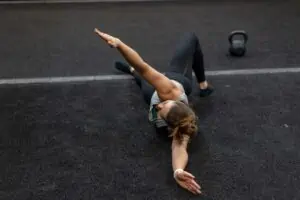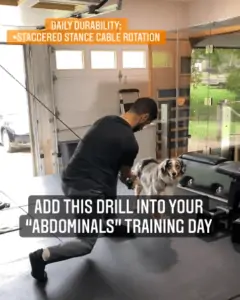Abs and core are two words we tend to use interchangeably when we talk about the muscles around our stomach.
However, these two areas actually aren’t one and the same … and not knowing the difference can seriously impact your training, performance, and susceptibility to injuries!
Here we break down the difference between your abs and your core, and how rotational exercises can be the key to a strong middle AND less back pain.
Your Core And Why It’s Important

While many people tend to assume that our abs are our core, the reality is a bit different. Your core compromises more than 20 muscles in your stomach, hips, and lower back region, while your abs (rectus abdominis) are just a fraction of this whole.
Our core muscles aren’t only responsible for a flat stomach or visible abs (although a strong core helps, of course!), but they also help keep your spine stabilized, help you maintain an upright body position, and are critical for assisting you in bending forward, backward and twisting.
When we perform crunches or sit ups for our abs, we actually miss out on training a huge section of our core muscles. The few frontal abdominals we engage in a crunch are strengthened, but every other muscle running up and down your sides, lower back, and lower core are left untouched.
Why is this a problem?
Because every movement we make, even walking down the street and sidestepping a crack or puddle, requires our core muscles. In fact, just the very act of standing upright requires our obliques (the muscles running along the side of our stomachs) to be mildly engaged so that we remain balanced.
All movement also requires our transverse abdominis, the deepest of our abdominal muscles that wraps around our middle like a corset, to be engaged. This muscle plays a crucial role in everyday movements to protect and stabilize the spine, as well as keeping organs securely in their place.
When we train our “abs,” much of the transverse abdominis is left untrained … which can lead to weak support for our spine and all types of movement.
Benefits Of Training The Entire Core
Because our deep core muscles wrap around our entire middle and upper hips, training them correctly can result in better spine support, improved balance, less back pain, reduced injury risk, and improved posture. Plus, having a strong core foundation can also lend more power to lifts and other movements, since your center of force is strong.
Studies have shown that having a strong core can help protect your spine during compound lifting movements like squats and deadlifts, as well as in any rotational and jumping movement (which is why this is also critical for any sport player!).
You can think of these deep core muscles as a type of secure cushioning that holds your spine and other joints in place during movement. In the same way that moving boxes that are packed well with plenty of bubble wrap secure your valuables better than boxes packed with no bubble wrap, strengthening your core keeps all of your body’s “valuables” in place.
Activating Your Core

If you haven’t trained your core much, it may take a moment to learn how to properly engage its muscles. If you’ve ever performed a plank, you may have tried to engage your abs by “sucking” then in, but this is a little different from actually engaging your transverse abdominis.
Practice this engaging technique before moving on to exercises:
Relax your torso by either lying facing the ceiling, or sitting comfortably in a chair. If lying down, make sure to keep a natural curve in your spine (aka: don’t try to tuck in your spine to fall flat on the floor). If sitting, make sure that your rib cage stacks on top of your pelvis and your shoulders on top of your cage.
Take a deep inhale with your diaphragm, filling your belly with a deep breath that expands your entire abdomen. Follow with a slow, yet deep exhale, making a powerful “sssssss” sound. As you exhale, imagine drawing your hipbones in towards one another. You can also imagine your exhale drawing your obliques to the front of your torso, near your belly button. “Knitting” the bottom of your ribcage together can also help connect you to the upper portion of the transverse abdominis.
This simple technique will help activate the entire core together, instead of it’s individual muscles. Practice this once a day, or at least several times per week for a few minutes until you can feel your core engaging naturally.
Exercises That Strengthen Your Core
Many exercises that engage your deep core muscles are stabilization and rotational exercises.
These includes planks (both traditional and side planks) and exercises like the one I share below:
Staggered Stance Cable Rotation

Incorporating planks and other rotational exercises can have a profound effect on your overall strength and performance, as well as possibly ease low back pain. For more exercises like these daily, download the Durable Athlete app (p.s.: you can get a 14-day FREE Trial here!).
